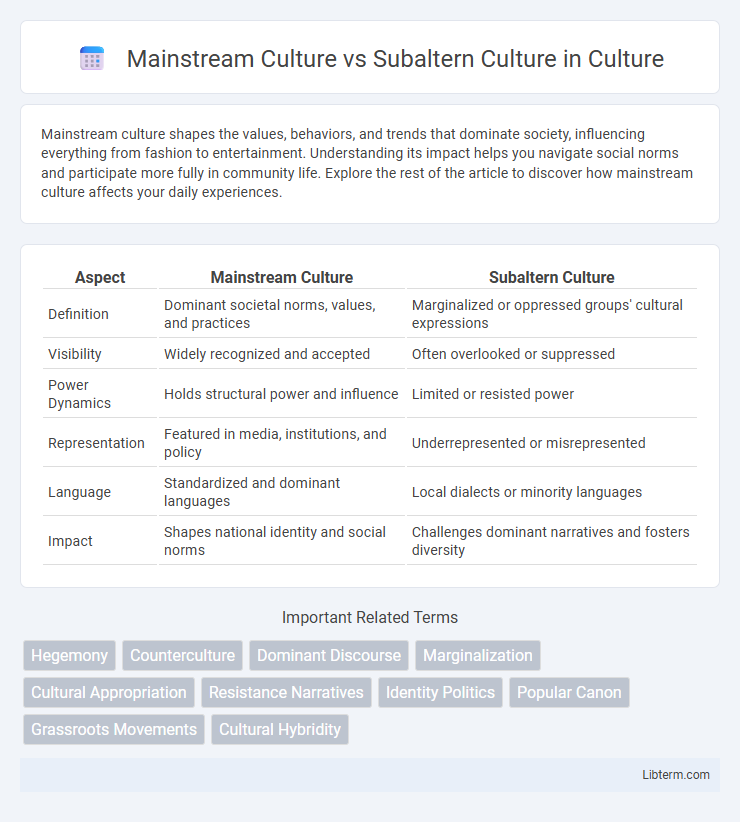Mainstream culture shapes the values, behaviors, and trends that dominate society, influencing everything from fashion to entertainment. Understanding its impact helps you navigate social norms and participate more fully in community life. Explore the rest of the article to discover how mainstream culture affects your daily experiences.
Table of Comparison
| Aspect | Mainstream Culture | Subaltern Culture |
|---|---|---|
| Definition | Dominant societal norms, values, and practices | Marginalized or oppressed groups' cultural expressions |
| Visibility | Widely recognized and accepted | Often overlooked or suppressed |
| Power Dynamics | Holds structural power and influence | Limited or resisted power |
| Representation | Featured in media, institutions, and policy | Underrepresented or misrepresented |
| Language | Standardized and dominant languages | Local dialects or minority languages |
| Impact | Shapes national identity and social norms | Challenges dominant narratives and fosters diversity |
Defining Mainstream Culture: Core Elements and Influence
Mainstream culture is defined by widespread societal norms, dominant values, and common practices shared by the majority within a society, shaping collective identity and social behavior. Its core elements include mass media representation, institutional endorsement, and prevailing language, which reinforce dominant ideologies and cultural narratives. The influence of mainstream culture extends to setting standards for acceptable conduct, aesthetic preferences, and social expectations, often marginalizing subaltern or minority cultural expressions.
Understanding Subaltern Culture: Origins and Perspectives
Subaltern culture originates from marginalized communities that resist dominant mainstream cultural norms and narratives. It reflects unique social experiences, histories, and identities often overlooked or oppressed by prevailing power structures. Understanding subaltern culture requires analyzing its perspectives through the lens of postcolonial theory, which highlights power dynamics and hegemonic influences shaping cultural expression.
Historical Evolution of Mainstream and Subaltern Dynamics
Mainstream culture has historically evolved through dominant social, political, and economic powers, shaping predominant narratives and values that define societal norms. Subaltern culture emerges as a response and resistance to this dominance, preserving marginalized identities and alternative histories often excluded from mainstream discourse. The dynamic between mainstream and subaltern cultures reflects ongoing struggles over representation, power, and cultural legitimacy throughout history.
Power Structures: Dominance and Marginalization
Mainstream culture often reflects and reinforces dominant power structures by promoting values, norms, and practices upheld by those in control of social, political, and economic institutions. Subaltern culture emerges as a response to marginalization, representing the experiences and resistance of groups excluded from mainstream narratives and power dynamics. The tension between dominance and marginalization shapes cultural production, access to resources, and the visibility of diverse identities within society.
Representation in Media and Popular Narratives
Representation in media often privileges mainstream culture by amplifying dominant narratives, values, and identities that align with broader societal norms. Subaltern culture, by contrast, faces marginalization through underrepresentation or stereotypical portrayals, leading to a limited visibility that affects collective perception and cultural legitimacy. This disparity in popular narratives perpetuates power imbalances and influences how cultural authenticity and identity are constructed and understood within public discourse.
Language, Identity, and Cultural Expression
Mainstream culture often dictates dominant language norms, shaping identity around widely accepted linguistic standards, while subaltern culture preserves marginalized languages as a form of resistance and self-expression. Identity in mainstream culture aligns with dominant narratives reinforced through mass media, whereas subaltern groups use cultural expression such as oral traditions, code-switching, and localized dialects to assert alternative worldviews. These linguistic and expressive differences highlight power dynamics where subaltern culture challenges hegemony by maintaining distinct cultural identities within dominant societal frameworks.
Subaltern Resistance: Voices and Movements
Subaltern resistance emerges as a crucial force challenging mainstream culture by amplifying marginalized voices and creating alternative narratives that confront dominant power structures. Grassroots movements, oral histories, and artistic expressions from subaltern groups expose systemic inequalities and assert identities often erased in mainstream discourse. These acts of resistance foster cultural resilience and contribute to socio-political transformations by reshaping public consciousness and demanding inclusion.
Intersectionality: Class, Race, Gender, and Culture
Mainstream culture often reflects dominant values shaped by privileged class, race, and gender groups, marginalizing subaltern cultures that embody the experiences of oppressed or minority communities. Intersectionality highlights how overlapping identities--such as being a working-class woman of color--compound inequalities within cultural representation and access to social capital. Understanding these dynamics reveals the systemic biases embedded in cultural narratives and challenges to achieving true cultural equity.
Cultural Appropriation and Authenticity Debates
Mainstream culture often dominates media and consumer markets, leading to frequent instances of cultural appropriation where elements of subaltern cultures are borrowed without proper understanding or respect, sparking debates around authenticity and ownership. Subaltern culture resists homogenization by emphasizing lived experiences and historical context, highlighting the power imbalances that perpetuate exploitation and erasure. These authenticity debates center on who has the right to represent cultural symbols, practices, and narratives, challenging the commercialization and commodification prevalent in mainstream cultural exchanges.
Bridging the Divide: Toward Inclusive Cultural Dialogue
Bridging the divide between mainstream culture and subaltern culture requires fostering inclusive cultural dialogue that values diverse narratives and experiences. Emphasizing mutual respect and representation challenges dominant hegemonies and promotes social equity. Initiatives such as community-based programs, intercultural exchanges, and inclusive media platforms create spaces where marginalized voices influence the cultural mainstream.
Mainstream Culture Infographic

 libterm.com
libterm.com